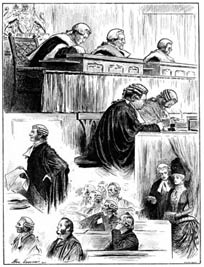Criminal law facts for kids
Criminal law is the body of law that relates to crime. Criminal law is the part of law that is about social norms. People who violate these norms are punished for their violation. Criminal law wants to protect certain values, such as life and limb, or property.
Criminal law includes the punishment and rehabilitation of people who violate such laws.
Criminal law varies according to jurisdiction, and differs from civil law, where emphasis is more on dispute resolution and victim compensation, rather than on punishment or rehabilitation.
History
The first civilizations generally did not distinguish between civil law and criminal law. The first written codes of law were designed by the Sumerians. Around 2100–2050 BC Ur-Nammu, the Neo-Sumerian king of Ur, enacted written legal code whose text has been discovered: the Code of Ur-Nammu although an earlier code of Urukagina of Lagash ( 2380–2360 BC ) is also known to have existed.
Another important early code was the Code of Hammurabi, which formed the core of Babylonian law. Only fragments of the early criminal laws of Ancient Greece have survived, e.g. those of Solon and Draco.

In Roman law, Gaius's Commentaries on the Twelve Tables also conflated the civil and criminal aspects, treating theft (furtum) as a tort. Assault and violent robbery were the same as trespassing. Breach of such laws created an obligation to pay monetary compensation or damages.
The criminal law of imperial Rome is collected in Books 47–48 of the Digest. After the revival of Roman law in the 12th century, sixth-century Roman classifications and jurisprudence provided the foundations of the distinction between criminal and civil law in European law from then until the present time.
The first signs of the modern distinction between crimes and civil matters emerged during the Norman Invasion of England. The special notion of criminal penalty, at least concerning Europe, arose in Spanish Late Scholasticism (see Alfonso de Castro). Codifiers and architects of Early Modern criminal law were the German jurist Benedikt Carpzov (1595-1666), professor of law in Leipzig, and two Italians, the Roman judge and lawyer Prospero Farinacci (1544-1618) and the Piedmontese lawyer and statesman Giulio Claro (1525-1575).
The development of the state dispensing justice in a court clearly emerged in the eighteenth century when European countries began maintaining police services.
Objectives
- Retribution – Criminals ought to suffer in some way. This is the most widely seen goal. Because of what they did, they profited from others, or they caused harm to them. As a consequence, criminal law will put criminals at some unpleasant disadvantage to "balance the scales". People submit to the law to receive the right not to be murdered and if other people act against these laws, they surrender the rights granted to them by these law. For this reason, one who murders may be executed himself. A related theory includes the idea of "righting the balance."
- Deterrence – Individual deterrence is aimed toward the specific offender. The aim is to impose a sufficient penalty to discourage the offender from criminal behavior. General deterrence aims at society at large. By imposing a penalty on those who commit offenses, other people are discouraged from committing those offenses.
- Incapacitation – Designed simply to keep criminals away from society so that the public is protected from their misconduct. This is often achieved through prison sentences today. The death penalty or banishment have served the same purpose.
- Rehabilitation – Aims at transforming an offender into a valuable member of society. Its primary goal is to prevent further offense by convincing the offender that their conduct was wrong.
- Restoration – This is a victim-oriented theory of punishment. The goal is to repair, through state authority, any injury inflicted upon the victim by the offender. For example, one who embezzles will be required to repay the amount improperly acquired. Restoration is commonly combined with other main goals of criminal justice and is closely related to concepts in the civil law, i.e., returning the victim to his or her original position before the injury.
See also
 In Spanish: Derecho penal para niños
In Spanish: Derecho penal para niños



